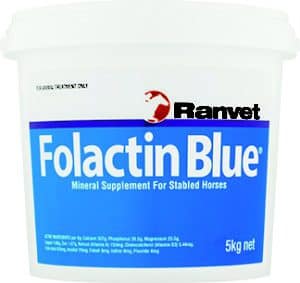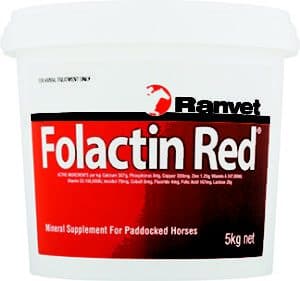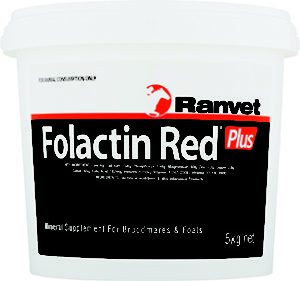The Importance of Calcium & Phosphorus in your horses diet
The Importance of Calcium and Phosphorus in your horses diet
Dietarily, minerals should be regarded as a group rather than individually. As the intake of a mineral increases above that needed, the amount absorbed and/or excreted in the urine and/or faeces also increases. An excess amount absorbed may be harmful. That not absorbed may bind other minerals, decreasing their absorption and possibly resulting in a deficiency of these minerals. This basically means that all minerals work together and should be available at not only the correct amounts in the diet but also in the correct proportion to each other.
It is the balanced amount of all minerals in the diet that is important.
Indiscriminately adding one or even several minerals to the diet is likely to be more harmful than beneficial. Minerals, therefore, should not be added to the diet unless it is known which ones and how much are needed.
The main minerals of concern in feeding horses are calcium, phosphorus, salt (sodium chloride), in some geographical areas selenium, and for growth copper and zinc.
Calcium and Phosphorus
Calcium and phosphorus comprise about 70% of the mineral content of the body and from 30 to 50% of the minerals in milk. About 99% of the calcium and over 80% of the phosphorus in the body are in the bones and teeth. However, both calcium and phosphorus play a critical role in numerous other body functions.
Calcium – necessary for blood coagulation, cell membrane function, glandular secretion, temperature regulation, the regulation of the activity of many enzymes, and mitochondrial and neuromuscular functions.
Phosphorus – necessary as a buffer, for energy metabolism and for numerous other cellular functions.
Dietary calcium and phosphorus deficiencies or excesses result in excess mobilisation or deposition of these minerals in bone, causing skeletal disease. Skeletal disease is usually classified in the following manner:
- Too little bone due to
a) inadequate osteoid production, resulting in osteoporosis (e.g. due to a mild prolonged calcium deficiency in the older animal)
b) insufficient osteoid mineralisation, which produces
(i) crickets in growing animals, and
(ii) osteomalacia in adults (a softening of the bones with accompanying pain and weakness)|
c) excess mineral resorption, resulting in fibrous osteodystrophy, e.g. due to a calcium deficiency-induced hyperparathyroidism - Too much bone, termed osteopetrosis, due to excessive bone mineralisation with insufficient bone resorption, e.g. due to excess calcium
Horses are more likely to suffer from a lack of calcium or phosphorus, and as a result skeletal diseases, than from a lack of any other minerals. As a nutritionist it is important to stay up to date with research carried out on recommended levels of minerals such as calcium and phosphorus. In my analysis of rations, particularly for growing foals, the amounts of calcium and phosphorus recommended in the horse’s daily diet have been increased by 15 to 20% because:
- The amount necessary to maximise bone strength and ash content is approximately this much higher than that required to maximise growth rate (Cromwell, 1984)
- The incidence of equine developmental orthopaedic disease has been reported to be lower with higher dietary levels (Knight et al., 1985)
- Amounts even higher than those recommended are not harmful (Schryver et al., 1987, Whitlock et al., 1970)
To meet an animal’s needs, the diet must not only contain adequate amounts of appropriate nutrients, but, in addition, the animal must be able to absorb and utilise them. A number of substances in the diet may decrease either calcium or phosphorus absorption.
- Excess dietary phosphorus in any form binds calcium, preventing its absorption. In contrast excess dietary calcium has little effect on phosphorus absorption (Schryver et al., 1974). This is because, in the horse, calcium is absorbed in the small intestine, whereas net phosphorus absorption occurs in the large intestine (Stadermann et al., 1992). Most excess calcium ingested is absorbed from the small intestine and excreted in the urine; it is, therefore, not available to decrease phosphorus absorption from the large intestine. Thus, excess dietary calcium is much less detrimental than excess phosphorus. If quantities of both calcium and phosphorus in the diet are adequate to meet the animal’s requirements, the amount of calcium with respect to phosphorus, or the Ca : P ratio, in the diet of the mature horse probably can vary from 0.8 : 1 to 8 : 1, and in the growing horse from 0.8 : 1 to 3 : 1 without resulting in problems. However, as a safety margin and because of the variation in the content and availability of calcium and phosphorus in feeds, a ratio of less than 1 : 1 is not recommended for any horse, and a ratio of grater than 6 : 1 is not recommended for the mature horse. This Ca : P ratio however is of secondary importance. Of primary importance is sufficient amounts of both calcium and phosphorus in the diet to meet the animal’s requirements. Unless the diet contact adequate amounts of both calcium and phosphorus, their ratio is of little importance.
If the amount of calcium or phosphorus is insufficient to meet the horse’s requirement, or if the amount of one mineral with respect to the other is outside of these ratios, skeletal alterations may occur.
- The lack of an adequate amount of the active form of vitamin D decreases intestinal calcium absorption.
Calcium deficiency/Phosphorus excess
Excess phosphorus in the horse’s diet only occurs if bran constitutes the majority of the diet, or if excess phosphorus-containing mineral supplements are fed. While some people believe high cereal grains can cause a phosphorus excess, this is not quite true. Cereal grains contain only about twice as much phosphorus as needed for maintenance and less than that needed for rapid growth, but they contain only 7 to 35% as much calcium as needed. Thus, the problem with a high cereal diet is not excess phosphorus, it’s inadequate calcium.
Grazing sub-tropical and tropical pasture and forage species
Much of the pasture base for horses in temperate regions of Australia contains kikuyu, often as a volunteer species, particularly under irrigated, high fertility conditions. In northern regions of Australia, while kikuyu is an important species for horses, other sub-tropical and tropical species are widely sown for horse pastures. Most of these species contain calcium as calcium oxalates (crystals of calcium oxalate in the grass blades) which is insoluble in the high alkaline environment in the small intestine and prevents the horse from absorbing calcium from the grass during digestion. Although the calcium oxalate is broken down in the hindgut by bacteria to release calcium, it is not absorbed well from the small intestine. This leads to calcium deficiency and the condition known as Nutritional Secondary Hyperparathyroidism (NSH) with symptoms of reduced bone strength, joint abnormalities and “big head” in severe cases.
The signs of big head include:
- lameness – animals appear stiff and have a shortened gait.
- illthrift – loss of condition on pastures which look nutritious.
- swollen jaw bones – upper jaws, lower jaws or both.
The prevalence of calcium deficiency in herds grazing pastures containing oxalates varies however 100% of horses may be affected, with the onset of clinical signs varying from two to eight months after being on the pastures (McKenzie, 1985).
Cases of big head have occurred on pastures of the introduced tropical species buffel grass, green panic, setaria, kikuyu, guinea grass, para grass, pangola grass and signal grass. Purple pigeon grass is also hazardous. The hazard is greatest when these grasses provide all, or almost all, the feed available. Native grasses have not caused the disease. Introduced temperate grasses, eg. rye grass and the sorghums, have not caused big head.
Despite this constraint, horses can be quite successfully grazed and bred on these species without any problems (they form the base on many Queensland farms). The oxalate issues are avoided through correct supplementation of calcium and phosphorus. A supplement of trace-minerals, as well as calcium and phosphorus including copper, zinc, manganese, iodine (and selenium on coastal country) should be provided to breeding and growing horses. Under these conditions, sub-tropical and tropical pastures and forages are highly productive and a valuable source for horses in the warm to hot northern regions.
Lucerne hay is an excellent source of calcium for horses. Its calcium availability has been shown to be even higher then the 67 to 73% from limestone and dicalcium phosphate.
Much of the lameness, tendinitis, and spontaneous fractures in racing Thoroughbred in Australia has been speculated to be due to inadequate dietary calcium (Caple et al., 1982). Most of these horses’ diet during racing and training consists of over 75% cereal grains which contain less than 0.1% calcium and over 0.3% phosphorus. Based on elevated renal clearance ratios of phosphorus, it was concluded that 40% of these horses were receiving inadequate calcium.
Diagnosis and treatment of a calcium deficiency
Inadequate calcium absorption is best diagnosed and correct by evaluating calcium and phosphorus content through dietary analysis (comparing nutrient composition of feeds to nutrient requirements of the horse). Regardless of the cause, blood values are of little benefit in diagnosing dietary calcium imbalances because they fluctuate, with little consistent change occurring as a result of either inadequate or excessive calcium consumption. Treatment of a dietary calcium deficiency or phosphorus excess is to correct the diet by increasing calcium and/or decreasing phosphorus. For the first two to three months, they should be twice that needed to meet the horse’s requirements, after which they should be decreased to that required. Ensure that the total diet Ca : P ratio is 1 : 1 to 3 : 1. Prolonged excessive calcium intake (greater than five times maintenance requirements) should be avoided; during recovery it may result in excessive bone density and inadequate bone remodelling, which may prevent bone strength from returning to normal upon recovery (Bertone, 1992).
When the calcium deficiency is due to excess oxalate intake, the preferred treatment is to decrease oxalate intake by not feeding high-oxalate-containing feeds, and, for the first two to three months, to feed a diet that provides twice the calcium and phosphorus required at a ratio of 1 : 1 to 3 : 1. After this time, ensure that the diet meets the horse’s calcium and phosphorus requirement.
References
Bertone, J.J. (1992). Nutritional secondary hyperparathyroidism. In Current Therapy Equine Medicine. 3rd Edn. Eds Robinson, N.E. WB Saunders, Philadelphia pp 119-122.
Caple, I.W. et al. (1982). Assessment of the calcium and phosphorus nutrition in horses by analysis of urine. Aust Vet J 58, 125-131.
Cromwell, G.L. (1984). Recent development in minerals and antibodies research in swine. Proc Monsanto Tech Symp, pp 13-56.
Knight, D.A. et al. (1985). Correlation of dietary mineral to incidence and severityof metabolic bone disease in Ohio and Kentucky. Proc Am Assoc Equine Pract, pp 445-461.
Kohnke, J. et al. (1999). Feeding horses in Australia. RIRDC Publication No 99/49.
Lewis, L.D. (1985). Equine Clinical Nutrition: Feeding and Care. Eds Cann, C. Williams & Wilkins, USA. pp25-35.
McKenzie, R.A. (1985). Poisoning of horses by oxalate in grasses. In Plant Toxicology. Eds Seawright, A.A. et al. Anim Res Inst Yeerongpilly, Qld Aust. Pp 150-154.
Schryver, H.F. et al. (1974). Calcium and phosphorus in nutrition of the horse. Cornell Vet 64, 491-515.
Schryver, H.F. et al. (1987). Growth and calcium levels in horses fed various levels of protein. Eq Vet J 19, 280-287.
Stadermann, B. et al. (1992). Calcium and magnesium absorption with roughage or mixed feed. Proc European Conf on Nutrition for Horses, pp 77-80.
Whitlock, R.H. et al. (1970). The effects of high dietary calcium for horses. Proc Am Assoc Equine Pract, p. 127.
Experts in Equine Nutrition
Every product in the Ranvet range has been developed to meet a horse’s most specific need at any given time, be it in a training environment or on a breeding farm. Having pioneered the formulation of specific medications and dietary supplements for horses, the company is now recognised as a leader in the areas of equine health and nutrition.



